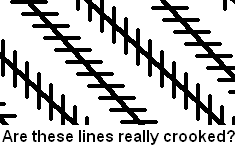 The goal of the Infamous Brick Puzzle (as I call it) is to draw a continuous curve that goes through each of the sixteen line segments in the above diagram exactly once. The Infamous Brick Puzzle is impossible--that's why it's infamous.
The goal of the Infamous Brick Puzzle (as I call it) is to draw a continuous curve that goes through each of the sixteen line segments in the above diagram exactly once. The Infamous Brick Puzzle is impossible--that's why it's infamous.Though it's only a harmless delusion, I find that it still aggravates me! It annoys me because it demonstrates how easily people can fool themselves, and simultaneously demonstrates how bad people are at math.
Of course, I may be a bit biased here, because I think the Brick Puzzle is just the easiest thing ever. Surely, it should be obvious that we should check parity considerations first! But upon further thought, I suppose most people wouldn't even know what I mean by that.
Part of the reason the Brick Puzzle fools people so easily is because it foils expectations. To demonstrate, let's take a look at this optical illusion.
 They sure look crooked, but because I already told you it's an optical illusion, you know they're really parallel. This is called the Zollner illusion! If you check it carefully, you'll find that they are actually parallel.
They sure look crooked, but because I already told you it's an optical illusion, you know they're really parallel. This is called the Zollner illusion! If you check it carefully, you'll find that they are actually parallel.Did anyone try checking it? If you did, you'd find that I was lying--they really aren't parallel at all. If you were fooled, you can't blame your eyes this time! You were fooled because of the context. You were told it was an optical illusion, so you naturally expected that whatever you plainly saw was only an illusion.
Similarly, if someone gives you a puzzle, you naturally expect there to be a solution. If you can't find the solution, it's probably because there's some kind of special trick to it. It is a classic puzzle after all, so it must be really clever. The one trick you do not expect is that there is no solution after all. That wouldn't be clever at all, would it?
Another thing is that the Brick Puzzle is typically presented by a teacher to his or her (often very young) students. The teacher promises that there is in fact a solution, and that she'll award fifty dollars to the first student to solve it. Well, the teacher wouldn't dare give us a puzzle with a stupid answer like "It's actually impossible", would he/she? We have greater faith in authority than that. Besides, if we try to look for a solution, we have nothing to lose and fifty bucks to gain. If we try to prove it's impossible, there's nothing to lose or gain (Pascal's wager all over again). Hope springs eternal.
There are a lot of rumors floating around which say the puzzle is possible. Some of it comes from people who like to keep the legend alive. It's pretty funny, in an evil maniacal laughter sort of way. Other times, these rumors originate because a person thinks he's found a solution, but hasn't checked it over thoroughly enough. When that person comes back to the puzzle, he discovers that he can't find a solution anymore. He attributes this to a failure of memory rather than a failure to count the number of line-crossings.
Another interesting thing that happens, is that I get all sorts of "creative" solutions. People seem to prefer a trick solution to a non-solution. Just fold the paper! Use a thick marker! Draw a line incidental with the edge of a brick!
These "creative" solutions exploit loopholes in the puzzle. People seem to think that those loopholes were intentionally placed there by the puzzle's author. Sometimes that is true, but let me tell you a little something about writing word puzzles. It is very difficult to close every loophole! I've found that if people are desperate enough to solve a puzzle, they find all sorts of loopholes, real or imagined. And if I try to close them all, I might end up with a very clunky and verbose presentation. We puzzle-writers are not gods! We are not perfect! Even classic puzzles are frequently imperfect (the ur-example being the -gry puzzle).
I don't mean to say that I'm annoyed when people keep on coming up with loopholes in my puzzles. Loopholes are fun to look for, after all. But sometimes people just use loopholes as an excuse to give up. Anyways, an impossibility proof is just as clever as any of those! Don't people appreciate a good mathematical proof?









1 comment:
Ha! I knew the lines were crooked the whole time, and didn't believe you when you said they were really parallel! WIN! ;-)
Post a Comment